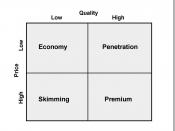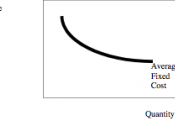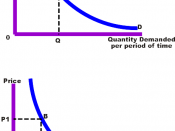INTRODUCTION
The board of a small hotel group in Dorset and Hampshire need to select a pricing strategy for their new brochure. Dorset and Hampshire is a seasonal area with a higher occupancy in the summer time then the winter. This would have an effect on the pricing strategy eventually chosen. Pricing is the only element of the marketing mix that does not represent cost. Therefore it is very important to gain the correct strategy otherwise the business can loose revenue or face closure. There are different pricing methods involved, these are, cost orientated pricing, market orientated pricing, profit orientated pricing and competitor pricing. The marketing manager wishes to use market orientated pricing, whilst the accountant wishes to use cost orientated pricing. The following analysis will show the various methods that can be used for pricing along with the advantages and disadvantages for each.
COST ORIENTATED PRICING
The accountant wishes the hotel group to use cost orientated pricing.
This includes four different methods which are; cost plus pricing, factor pricing, break even pricing and actual cost approach. These are all based around the cost of the product or service.
Cost Plus Pricing
This is the most basic form of cost orientated pricing. It involves a % mark-up on an established price. The basic equation for this is;
çÂÂçÂÂçÂÂçÂÂP = C + F(C) çÂÂçÂÂçÂÂç çÂÂçÂÂçÂÂç çÂÂçÂÂçÂÂçÂÂP - Price
çÂÂçÂÂçÂÂç çÂÂçÂÂçÂÂç çÂÂçÂÂçÂÂç çÂÂçÂÂçÂÂç çÂÂçÂÂçÂÂçÂÂC - Costs
çÂÂçÂÂçÂÂç çÂÂçÂÂçÂÂç çÂÂçÂÂçÂÂç çÂÂçÂÂçÂÂç çÂÂçÂÂçÂÂçÂÂF - % mark-up
The % mark-up will depend on what other 'costs' need to be covered that may not already have been covered. As there are different types of 'costs' these can then be altered to show, full cost, direct cost and gross margin pricings.
Full Cost; çÂÂçÂÂçÂÂçÂÂ
Cost Base çÂÂçÂÂçÂÂç çÂÂçÂÂçÂÂç çÂÂçÂÂçÂÂç çÂÂçÂÂçÂÂç çÂÂçÂÂçÂÂçÂÂ
Mark-Up
Direct Material çÂÂçÂÂçÂÂçÂÂDirect Labour çÂÂçÂÂçÂÂçÂÂ...


